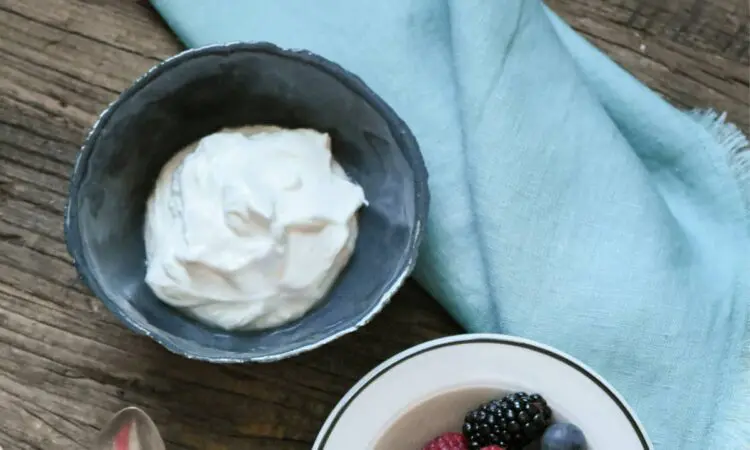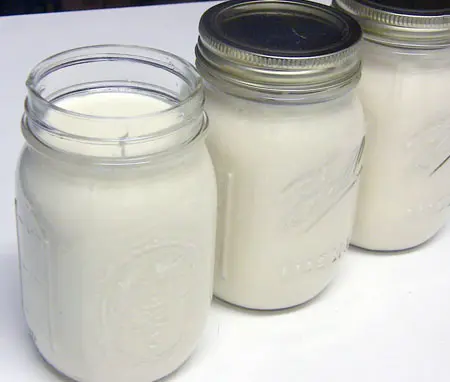Yogurt is a great, kid-friendly source of natural probiotics, an integral part of a healthy diet. Eating live culture yogurt helps maintain the balance of microflora in the intestines, bolsters the immune system, and alleviates food allergies. I always thought yogurt-making would be too precise and complicated for me, and then, I found this simple method for How To Make Yogurt Without A Yogurt Maker which yields twelve six ounce yogurts from five dollars worth of ingredients. Using a homemade yogurt recipe makes it affordable to eat yogurt everyday. Plus, you will love this creamy French-style yogurt!
This recipe is reprinted with permission. It is an excerpt from Billie Sharp’s book Lemons and Lavender: The Eco Guide to Better Homekeeping (affiliate link). Bursting with ways to downshift, simplify, preserve resources, and honor the planet, Lemons and Lavender will give you tools to reclaim a purer, tastier, healthier and less expensive way of life. Sharp shares her radical common sense and revolutionary “freeconomics” approach to budgeting in this step-by-step guide to the good life. You can read a review at EcoChildsPlay.
This recipe was first publish April 3, 2012. I have added a recipe card and republished it here for my new readers to enjoy.
Delicious French-Style Plain Yogurt Recipe
Making homemade yogurt has several benefits:
- Healthier Ingredients: You control the ingredients, avoiding additives, preservatives, and excess sugar often found in store-bought yogurt.
- Cost-Effective: Homemade yogurt can be more affordable than purchasing high-quality or specialty yogurts, especially if you consume it regularly.
- Customizable: You can adjust the flavor, thickness, and tanginess of your yogurt to your liking, as well as experiment with different types of milk (like plant-based or organic).
- Probiotic-Rich: Yogurt is a great source of probiotics, which are good for gut health. Making it fresh ensures the active cultures are alive and beneficial.
- Sustainability: Homemade yogurt reduces plastic packaging waste associated with store-bought containers.
Yogurt made with whole milk, results in a creamier, more luxurious taste and texture compared to low-fat yogurts. Unlike Greek yogurt, which is strained to remove whey, French-style yogurt isn’t strained, so it has a smoother, thinner consistency than Greek yogurt but thicker than traditional American yogurt. French yogurt is usually cultured directly in the individual serving container it will be served it, giving it a firmer texture and allowing it to retain a rustic appearance.
Homemade Yogurt Ingredients
- 1 gallon of milk (skim milk works or use whole milk if you like French yogurt which is rich and creamy)
- 1 small pot of plain unsweetened live yogurt
- regular cooler, [big enough for a few pitchers and 24 small jars]
- kitchen thermometer
- 3 plastic pitchers
- 3 quart size mason jars or 15 small glass jars (canning jars work well or reuse the Oui French style yogurt glass pots)
This easy yogurt recipe is nice and simple. No yogurt starter required. Just a small 5 oz container of plain yogurt will do the trick! It can be store-bought yogurt or homemade yogurt that you use to introduce the live cultures.

How To Make Yogurt:
First, sterilize the glass jars or pots that the yogurt will be decanted into. Simply sterilize clean jars by pouring boiling water into them and letting them sit for five minutes, afterwards emptying the water out.
Pour the milk into a large saucepan and heat slowly on the stovetop, stirring gently. When the milk’s temperature is 170 degrees fahrenheit (76˚C), turn the heat off and continue to stir for a few minutes to make sure the milk doesn’t stick to the bottom of the pan and burn.
When the milk is at 105-110˚F (40-43˚C) mix up the little pot of yogurt so it’s smooth and then add it to the milk. Stir the yogurt in well; this inoculates the milk with the yogurt culture. For best results, make sure the yogurt is fully dissolved in the milk.
Pour the milk mixture into the twelve sterilized jars and then place them in the cooler. Add the three pitchers filled with hot water from the tap, close the cooler lid, and leave the cooler in one place without moving it.
The fermentation process will take four to eight hours. If you feel concerned about the cooler temperature, you can refill the pitchers with hot water midway. Be sure to keep the lid closed as much as possible while you are re-heating the pitchers.
When the yogurts are set, you can cap the yogurt containers and store finished yogurts in the fridge. And that is for how to make yogurt without a yogurt maker!
Just add fresh fruit or honey or both to your homemade yogurt if you fancy!

Printable Yogurt Recipe Card
Plain Yogurt Recipe
Notes
Supplies Needed:
cooler, kitchen thermometer, 3 plastic pitchers, 15 small glass jars or 3 quart sized mason jars
Ingredients
- 1 gallon of whole or low fat milk
- 5 oz plain unsweetened live yogurt
Instructions
- First sterilize the glass jars or pots that the yogurt will be decanted into. Simply sterilize clean jars by pouring boiling water into them and letting them sit for five minutes, afterwards emptying the water out.
- Pour the milk into a large saucepan and heat slowly on the stovetop, stirring gently. When the milk’s temperature is 170˚F (76˚C), turn the heat off and continue to stir for a few minutes to make sure the milk doesn’t stick to the bottom of the pan and burn.
- When the milk is at 105-110˚F (40-43˚C) mix up the little pot of yogurt so it’s smooth and then add it to the milk. Stir the yogurt in well; this inoculates the milk with the yogurt culture. For best results, make sure the yogurt is fully dissolved in the milk.
- Pour the milk mixture into the twelve sterilized jars and then place them in the cooler. Add the three pitchers filled with hot water from the tap, close the cooler lid, and leave the cooler in one place without moving it.
- The fermentation process will take four to eight hours. If you feel concerned about the cooler temperature, you can refill the pitchers with hot water midway. Be sure to keep the lid closed as much as possible while you are re-heating the pitchers.
- When the yogurts are set, you can cap them and store them in the fridge.
Nutrition Facts
Plain Yogurt Recipe
Serves: 12
| Amount Per Serving: | ||
|---|---|---|
| Calories | 143.85 kcal | |
| % Daily Value* | ||
| Total Fat 3.54 g | 4.6% | |
| Saturated Fat 2.31 g | 10% | |
| Trans Fat | ||
| Cholesterol 17.8 mg | 5.7% | |
| Sodium 148.58 mg | 6.2% | |
| Total Carbohydrate 16.78 g | 5.3% | |
| Dietary Fiber 0.0 g | 0% | |
| Sugars 17.47 g | ||
| Protein 11.37 g | ||
| Vitamin A 191.88 µg | Vitamin C 0.06 mg | |
| Calcium 420.96 mg | Iron 0.1 mg | |
* Percent Daily Values are based on a 2,000 calorie diet. Your daily values may be higher or lower depending on your calorie needs.
Family Focus Blog
Homemade Yogurt Recipe Notes:
A yellow clear liquid will form on the top of the yogurt — this is called “whey” — and you can either stir it back into the yoghurt or pour it out.
If you want to use one of these yogurts as the starter for your next batch of yogurt then use it in the first week, otherwise freeze it and thaw out before using it.
The first time you do it, it will be alien to you but after a few times you will realize it is so easy!
The active part of the recipe is very quick really, it is the sitting and setting that takes the time.
Store homemade yogurt in an airtight container in the refrigerator.
How long does homemade yogurt last? I suggest eating it within 2 weeks of making it.
Conclusion
Making homemade yogurt offers numerous benefits, from healthier, customizable ingredients to cost savings and sustainability. By crafting yogurt at home, you can control its flavor, thickness, and nutritional content, ensuring a rich source of probiotics without the additives often found in store-bought varieties. The process is simple, rewarding, and allows for creative experimentation with different milk types and flavors. Whether you prefer the creaminess of French-style yogurt or a tangier option, homemade yogurt delivers a wholesome, delicious product tailored to your preferences while promoting gut health and reducing waste.
This yogurt is both delicious and healthy for you. I hope you try this homemade yogurt recipe and that you find it easy to use and delicious as I do. Did you find this recipe for how to make yogurt without a yogurt maker helpful? Have you ever made your own yogurt before?
Related Healthy Recipes:


Marco says
This post is very enlightening! Your clear and concise writing style makes it easy to grasp how to make yogurt which is something I never thought I could do myself! I appreciate the practical recipe tips. Thank you for taking the time to create such a valuable resource. I have been eating yogurt everyday so making it myself should help save me tons of money.
Darryl says
This fancy yogurt recipe is easy to follow— thank you.
Rade Radosvljevic says
I love this! It’s so helpful to know that you don’t need a yogurt maker to create delicious homemade yogurt. The method you’ve shared is simple and straightforward, and I am so glad I tried it out. There’s something really satisfying about making your own yogurt from scratch. Thanks for the great tips!
Jean says
Thanks for sharing this easy homemade yogurt recipe! I love how simple the process is, and I can’t wait to try it out. It’s great to know exactly what’s going into my yogurt. It will be fun to experiment with topping variations too.
William says
Wow, this yogurt recipe is so easy and delicious! I love that I can control the ingredients and make it just the way I like. Thanks for sharing this!
Malik shihab says
Thanks for sharing this easy homemade yogurt recipe. This yogurt recipe is so easy and delicious I am so glad I tried it out.